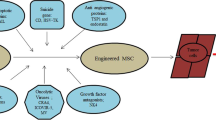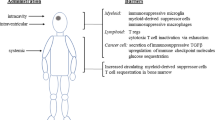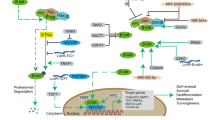Abstract
We have created a novel cellular vehicle for gene therapy of malignant gliomas by transfection of murine bone marrow stroma cells (MSCs) with a cDNA encoding epidermal growth factor receptor (EGFR). These cells (EGFR-MSCs) demonstrate enhanced migratory responses toward glioma-conditioned media in comparison to primary MSCs in vitro. Enhanced migration of EGFR-MSC was at least partially dependent on EGF-EGFR, PI3-, MAP kinase kinase, and MAP kinases, protein kinase C, and actin polymerization. Unlike primary MSCs, EGFR-MSCs were resistant to FasL-mediated cytotoxicity and were capable of stimulating allogeneic mixed lymphocyte reaction, suggesting EGFR-MSCs possess suitable characteristics as vehicles for brain tumor immuno-gene therapy. Following injection at various sites, including the contralateral hemisphere in the brain of syngeneic mice, EGFR-MSCs were able to migrate toward GL261 gliomas or B16 melanoma in vivo. Finally, intratumoral injection with EGFR-MSC adenovirally engineered to secrete interferon-α to intracranial GL261 resulted in significantly prolonged survival in comparison to controls. These data indicate that EGFR-MSCs may serve as attractive vehicles for infiltrating brain malignancies such as malignant gliomas.
This is a preview of subscription content, access via your institution
Access options
Subscribe to this journal
Receive 12 print issues and online access
$259.00 per year
only $21.58 per issue
Buy this article
- Purchase on Springer Link
- Instant access to full article PDF
Prices may be subject to local taxes which are calculated during checkout






Similar content being viewed by others
References
Aboody KS, Brown A, Rainov NG, et al. Neural stem cells display extensive tropism for pathology in adult brain: evidence from intracranial gliomas. Proc Natl Acad Sci USA. 2000;97:12846–12851.
Gage FH . Mammalian neural stem cells. Science. 2000;287:1433–1438 (Review) (55 refs).
Robertson JA . Ethics and policy in embryonic stem cell research. Kennedy Inst Ethics J. 1999;9:109–136.
Deng Y, Guo X, Yuan Q, Li S . Efficiency of adenoviral vector mediated CTLA4Ig gene delivery into mesenchymal stem cells. Chin Med J (Engl.). 2003;116:1649–1654.
Dunn IF, Heese O, Black PM . Growth factors in glioma angiogenesis: FGFs, PDGF, EGF, and TGFs. J Neurooncol. 2000;50:121–137.
Wilson AJ, Gibson PR . Role of epidermal growth factor receptor in basal and stimulated colonic epithelial cell migration in vitro. Exp Cell Res. 1999;250:187–196.
Faber-Elman A, Solomon A, Abraham JA, Marikovsky M, Schwartz M . Involvement of wound-associated factors in rat brain astrocyte migratory response to axonal injury: in vitro simulation. J Clin Invest. 1996;97:162–171.
Qin P, Kurpakus MA . The role of laminin-5 in TGF alpha/EGF-mediated corneal epithelial cell motility. Exp Eye Res. 1998;66:569–579.
Krueger JS, Keshamouni VG, Atanaskova N, Reddy KB . Temporal and quantitative regulation of mitogen-activated protein kinase (MAPK) modulates cell motility and invasion. Oncogene. 2001;20:4209–4218.
El Obeid A, Bongcam-Rudloff E, Sorby M, Ostman A, Nister M, Westermark B . Cell scattering and migration induced by autocrine transforming growth factor alpha in human glioma cells in vitro. Cancer Res. 1997;57:5598–5604.
Chicoine MR, Silbergeld DL . Mitogens as motogens. J Neurooncol. 1997;35:249–257.
Pedersen PH, Ness GO, Engebraaten O, Bjerkvig R, Lillehaug JR, Laerum OD . Heterogeneous response to the growth factors [EGF, PDGF (bb), TGF-alpha, bFGF, IL-2] on glioma spheroid growth, migration and invasion. Int J Cancer. 1994;56:255–261.
Mishima K, Higashiyama S, Asai A, et al. Heparin-binding epidermal growth factor-like growth factor stimulates mitogenic signaling and is highly expressed in human malignant gliomas. Acta Neuropathol (Berl.). 1998;96:322–328.
Morse WR . Chinese Medicine. New York: Hoeber; 1938.
La Russa VF, Schwarzenberger P, Miller A, Agrawal K, Kolls J, Weiner R . Marrow stem cells, mesenchymal progenitor cells, and stromal progeny. Cancer Invest. 2002;20:110–123.
Kopen GC, Prockop DJ, Phinney DG . Marrow stromal cells migrate throughout forebrain and cerebellum, and they differentiate into astrocytes after injection into neonatal mouse brains. Proc Natl Acad Sci USA. 1999;96:10711–10716.
Sanchez-Ramos J, Song S, Cardozo-Pelaez F, et al. Adult bone marrow stromal cells differentiate into neural cells in vitro. Exp Neurol. 2000;164:247–256.
Azizi SA, Stokes D, Augelli BJ, DiGirolamo C, Prockop DJ . Engraftment and migration of human bone marrow stromal cells implanted in the brains of albino rats—similarities to astrocyte grafts. Proc Natl Acad Sci USA. 1998;95:3908–3913.
Yamada M, Suzu S, Tanaka-Douzono M, et al. Effect of cytokines on the proliferation/differentiation of stroma-initiating cells. J Cell Physiol. 2000;184:351–355.
Chen P, Gupta K, Wells A . Cell movement elicited by epidermal growth factor receptor requires kinase and autophosphorylation but is separable from mitogenesis. J Cell Biol. 1994;124:547–555.
Dieu MC, Vanbervliet B, Vicari A, et al. Selective recruitment of immature and mature dendritic cells by distinct chemokines expressed in different anatomic sites. J Exp Med. 1998;188:373–386.
Yanagihara S, Komura E, Nagafune J, Watarai H, Yamaguchi Y . EBI1/CCR7 is a new member of dendritic cell chemokine receptor that is up-regulated upon maturation. J Immunol. 1998;161:3096–3102.
Oyaizu N, Kayagaki N, Yagita H, Pahwa S, Ikawa Y . Requirement of cell–cell contact in the induction of Jurkat T cell apoptosis: the membrane-anchored but not soluble form of FasL can trigger anti-CD3-induced apoptosis in Jurkat T cells. Biochem Biophys Res Commun. 1997;238:670–675.
Takeda K, Hayakawa Y, Smyth MJ, et al. Involvement of tumor necrosis factor-related apoptosis-inducing ligand in surveillance of tumor metastasis by liver natural killer cells. Nat Med. 2001;7:94–100.
Okada H, Tahara H, Shurin MR, et al. Bone marrow derived dendritic cells pulsed with a tumor specific peptide elicit effective anti-tumor immunity against intracranial neoplasms. Int J Cancer. 1998;78:196–201.
Okada H, Tsugawa T, Sato H, et al. Delivery of Interferon-alpha transfected dendritic cells into central nervous system tumors enhances the antitumor efficacy of peripheral peptide-based vaccines. Cancer Res. 2004;64:5830–5838.
Rappold I, Ziegler BL, Kohler I, et al. Functional and phenotypic characterization of cord blood and bone marrow subsets expressing FLT3 (CD135) receptor tyrosine kinase. Blood. 1997;90:111–125.
Saas P, Walker PR, Hahne M, et al. Fas ligand expression by astrocytoma in vivo: maintaining immune privilege in the brain? J Clin Invest. 1997;99:1173–1178.
Okada H, Yoshida J, Sokabe M, Wakabayashi T, Hagiwara M . Suppression of CD44 expression decreases migration and invasion of human glioma cells. Int J Cancer. 1996;66:255–260.
Monaghan M, Mulligan KA, Gillespie H, et al. Epidermal growth factor up-regulates CD44-dependent astrocytoma invasion in vitro. J Pathol. 2000;192:519–525.
Hackel PO, Zwick E, Prenzel N, Ullrich A . Epidermal growth factor receptors: critical mediators of multiple receptor pathways. Curr Opin Cell Biol. 1999;11:184–189.
Sweeney C, Fambrough D, Huard C, et al. Growth factor-specific signaling pathway stimulation and gene expression mediated by ErbB receptors. J Biol Chem. 2001;276:22685–22698.
Devine SM, Peter S, Martin BJ, Barry F, McIntosh KR . Mesenchymal stem cells: stealth and suppression. Cancer J. 2001;7 (Suppl 2):S76–S82.
Abrahams VM, Kamsteeg M, Mor G . The Fas/Fas ligand system and cancer: immune privilege and apoptosis. Mol Biotechnol. 2003;25:19–30.
Tamiya T, Wei MX, Chase M, et al. Transgene inheritance and retroviral infection contribute to the efficiency of gene expression in solid tumors inoculated with retroviral vector producer cells. Gene Ther. 1995;2:531–538.
Okada H, Villa LA, Attanucci J, et al. Cytokine gene therapy of gliomas: effective induction of therapeutic immunity to intracranial tumors by peripheral immunization with interleukin-4 transduced glioma cells. Gene Ther. 2001;8:1157–1166.
Smith JS, Tachibana I, Passe SM, et al. PTEN mutation, EGFR amplification, and outcome in patients with anaplastic astrocytoma and glioblastoma multiforme. J Natl Cancer Inst. 2001;93:1246–1256.
Caric D, Raphael H, Viti J, Feathers A, Wancio D, Lillien L . EGFRs mediate chemotactic migration in the developing telencephalon. Development. 2001;128:4203–4216.
Wright DE, Bowman EP, Wagers AJ, Butcher EC, Weissman IL . Hematopoietic stem cells are uniquely selective in their migratory response to chemokines. J Exp Med. 2002;195:1145–1154.
Kim CH, Broxmeyer HE . SLC/exodus2/6Ckine/TCA4 induces chemotaxis of hematopoietic progenitor cells: differential activity of ligands of CCR7, CXCR3, or CXCR4 in chemotaxis vs suppression of progenitor proliferation. J Leukoc Biol. 1999;66:455–461.
Kruger JS, Reddy KB . Distinct mechanisms mediate the initial and sustained phases of cell migration in epidermal growth factor receptor-overexpressing cells. Mol Cancer Res. 2003;1:801–809.
Golubovskaya V, Beviglia L, Xu LH, Earp III HS, Craven R, Cance W . Dual inhibition of focal adhesion kinase and epidermal growth factor receptor pathways cooperatively induces death receptor-mediated apoptosis in human breast cancer cells. J Biol Chem. 2002;277:38978–38987.
Musallam L, Ethier C, Haddad PS, Bilodeau M . Role of EGF receptor tyrosine kinase activity in antiapoptotic effect of EGF on mouse hepatocytes. Am J Physiol Gastrointest Liver Physiol. 2001;280:G1360–G1369.
Saas P, Walker PR, Hahne M . Fas ligand expression by astrocytoma in vivo: maintaining immune privilege in the brain? J Clin Invest. 1997;99:1173–1178.
Wang X, McCullough KD, Franke TF, Holbrook NJ . Epidermal growth factor receptor-dependent Akt activation by oxidative stress enhances cell survival. J Biol Chem. 2000;275:14624–14631.
Franke TF, Kaplan DR, Cantley LC . PI3K: downstream AKTion blocks apoptosis. Cell. 1997;88:435–437.
Mangi AA, Noiseux N, Kong D, et al. Mesenchymal stem cells modified with Akt prevent remodeling and restore performance of infarcted hearts. Nat Med. 2003;9:1195–1201.
Reilly KM, Loisel DA, Bronson RT, McLaughlin ME, Jacks T . Nf1;Trp53 mutant mice develop glioblastoma with evidence of strain-specific effects. Nat Genet. 2000;26:109–113.
Bachoo RM, Maher EA, Ligon KL, et al. Epidermal growth factor receptor and Ink4a/Arf: convergent mechanisms governing terminal differentiation and transformation along the neural stem cell to astrocyte axis. Cancer Cell. 2002;1:269–277.
Okada H, Pollack IF, Lotze MT, et al. Gene therapy of malignant gliomas: a phase I study of IL4HSV-TK genemodified autologous tumor to elicit an immune response (clinical protocol). Human Gene Ther. 2000;11:637–653.
Berens C, Hillen W . Gene regulation by tetracyclines. Constraints of resistance regulation in bacteria shape TetR for application in eukaryotes. Eur J Biochem. 2003;270:3109–3121.
Hombauer H, Minguell JJ . Selective interactions between epithelial tumour cells and bone marrow mesenchymal stem cells. Br J Cancer. 2000;82:1290–1296.
Maestroni GJ, Hertens E, Galli P . Factor(s) from nonmacrophage bone marrow stromal cells inhibit Lewis lung carcinoma and B16 melanoma growth in mice. Cell Mol Life Sci. 1999;55:663–667.
Cooper CR, Chay CH, Gendernalik JD, et al. Stromal factors involved in prostate carcinoma metastasis to bone. Cancer. 2003;97:739–747.
Thyrell L, Erickson S, Zhivotovsky B, et al. Mechanisms of interferon-alpha induced apoptosis in malignant cells. Oncogene. 2002;21:1251–1262.
Santini SM, Lapenta C, Logozzi M, et al. Type I interferon as a powerful adjuvant for monocyte-derived dendritic cell development and activity in vitro and in Hu-PBL-SCID mice. J Exp Med. 2000;191:1777–1788, 2000; 191: 1777–1788.
Paquette RL, Hsu NC, Kiertscher SM, et al. Interferon-alpha and granulocyte-macrophage colony-stimulating factor differentiate peripheral blood monocytes into potent antigen-presenting cells. J Leukocyte Biol. 1998;64:358–367.
Honda K, Sakaguchi S, Nakajima C, et al. Selective contribution of IFN-alpha/beta signaling to the maturation of dendritic cells induced by double-stranded RNA or viral infection. Proc Natl Acad Sci USA. 2003;100:10872–10877.
Acknowledgements
This work was supported by P01 NS40923 (IFP, SCW, HO) and a grant from the Copeland Fund of the Pittsburgh Foundation (HO). We thank Dr Manabu Hatano for helpful discussions in the review of this manuscript.
Author information
Authors and Affiliations
Corresponding author
Rights and permissions
About this article
Cite this article
Sato, H., Kuwashima, N., Sakaida, T. et al. Epidermal growth factor receptor-transfected bone marrow stromal cells exhibit enhanced migratory response and therapeutic potential against murine brain tumors. Cancer Gene Ther 12, 757–768 (2005). https://doi.org/10.1038/sj.cgt.7700827
Received:
Published:
Issue Date:
DOI: https://doi.org/10.1038/sj.cgt.7700827
Keywords
This article is cited by
-
Genetically engineered mesenchymal stem cells: targeted delivery of immunomodulatory agents for tumor eradication
Cancer Gene Therapy (2020)
-
Translation, but not transfection limits clinically relevant, exogenous mRNA based induction of alpha-4 integrin expression on human mesenchymal stem cells
Scientific Reports (2017)
-
Third-party Mesenchymal Stem Cells Improved Human Islet Transplantation in a Humanized Diabetic Mouse Model
Molecular Therapy (2013)
-
Mesenchymal stem cells: from experiment to clinic
Fibrogenesis & Tissue Repair (2011)
-
Targeting of mesenchymal stem cells to ovarian tumors via an artificial receptor
Journal of Ovarian Research (2010)



